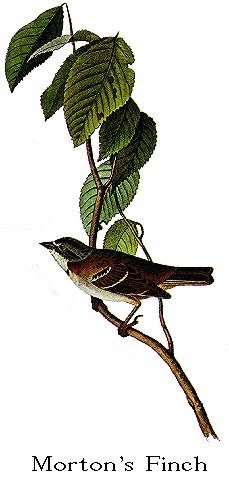
| Family XV. FRINGILLINAE. FINCHES. GENUS IX. FRINGILLA, Linn. FINCH. |
Next >> |

Family |
MORTON'S FINCH. [Rufous-collared Sparrow.] |
| Genus | FRINGILLA MORTONII. [Zonotrichia capensis.] |
A single specimen of this pretty little bird, apparently an adult male, has
been sent to me by Dr. TOWNSEND, who procured it in Upper California. Supposing
it to be undescribed, I have named it after my excellent and much esteemed
friend Dr. MORTON of Philadelphia, Corresponding Secretary of the Academy of
Natural Sciences of that city.
North California.
MORTON'S FINCH, Fringilla Mortoni, Aud. Orn. Biog., vol. v. p. 312.
Adult Male.
Bill short, stout, conical, compressed toward the end; upper mandible with
its dorsal outline declinate, almost straight, being slightly convex toward the
end, the ridge indistinct, the sides rounded, the edges sharp and somewhat
inflected, with a very faint notch close to the tip; lower mandible about the
same depth and nearly as broad at the base, its angle very short and rounded,
its dorsal line ascending, almost straight, being very slightly convex, the back
and sides convex, the edges inflected, the tip acute. Gap-line considerably
declinate at the base. Nostrils small, roundish, marginate, basal, in the fore
part of the short nasal depression, and partially concealed by the feathers.
Head rather large, ovate; neck short. Feet of ordinary length, tarsus much
compressed, with seven anterior scutella, and two plates behind meeting so as to
form a very thin edge; toes rather stout, compressed, the first large, the
second or inner scarcely shorter than the outer, which is united to the fourth
as far as the second joint; claws rather long, much compressed, laterally
grooved, moderately arched, acute.
Plumage soft and blended. Wings of moderate length, the first quill
two-twelfths of an inch shorter than the second, which is almost equal to the
third, the latter being the longest, the fourth scarcely half a twelfth shorter,
the rest slowly decreasing; secondaries long, truncate or abruptly rounded.
Tail of moderate length, nearly even, the middle feathers one-twelfth, the
lateral half a twelfth shorter than the rest.
Bill dusky, bluish toward the base. Feet and claws yellowish-brown. The
upper part of the head is ash-grey, with a longitudinal band of black on each
side from the bill to the occiput, externally of which is a greyish-white band;
loral space, cheek-coverts, and auriculars dusky, the feathers under the eye
tipped with white; the throat white, surrounded with a black band; a light
chestnut-red band surrounds the neck, except for a short space in front; the
fore part of the back and scapulars are light dull yellowish-red, streaked with
brownish-black, the hind part, rump, and upper tail-coverts yellowish-grey; the
smaller wing-coverts yellowish-grey, the first row brownish-black toward the
end, with the tip white, the secondary coverts and inner secondary quills
brownish-black, broadly margined with light yellowish-red, the former tipped
with white, the rest of the quill dusky brown, edged with yellowish-red fading
on the outer to whitish; the tail-feathers blackish-brown, narrowly edged with
pale yellowish-grey, the lateral of a lighter tint. The lower paints are dull
brownish-white, the sides light greyish-brown, the lower wing-coverts
yellowish-white.
Length to end of tail 5 1/2 inches; bill along the ride (4 3/4)/12, along
the edge of lower mandible 6/12; wing from flexure 2 11/12; tail 2 4/12, tarsus
(9 1/2)/12; hind toe (3 1/2)/12, its claw (4 1/2)/12; middle toe 7/12, its claw
(2 3/4)/12.
In its colouring this bird is very similar to the White-crowned and
White-chinned Finches, with which it also agrees in the form of its wings, but
differs in having the tail much shorter, the bill less robust, the claws
proportionally longer and less arched.
| Next >> |